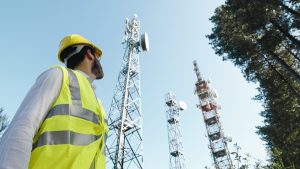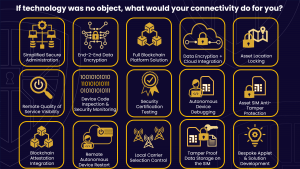In contrast to radio access networks, elements of which can be seen (e.g., cell towers), the core network usually remains an invisible part of cellular communication systems.
But what is a core network, what does it do, and why do these functions matter to you as an end-user?
Join Charles Bernard, CTO at ZARIOT, as we dive into the role of a core network, and highlight distinct benefits of having a connectivity provider with core network ownership.

What is a core network in the mobile telecoms industry?
The core network is the central element of a network as it provides services to customers who are connected by the access network.
Essentially, it controls all devices that are connected to it and determines any service they are allowed to use.
It is also the gateway to other networks to interconnect with. Either for voice calls, internet, private or public clouds or private enterprise networks.
What does a core network do?
Since it acts as a control centre, there are several vital services that it provides.
This includes:
- Subscriber authentication – Makes sure a subscriber is who it claims to be;
- Subscriber services – Determines which services subscribers can access (e.g., SMS, voice, data);
- Subscriber networks and countries – Controls geographically where services can be used;
- Service usage – Provides visibility intro how much credit a subscriber has left for data or SMS’s;
- Usage rating – Tracks how much data or how many SMS’s has been consumed.

Why is a core network vital when choosing an IoT connectivity provider?
In sum, a core network is instrumental in performing the most essential and basic functions like traffic routing, authentication, authorization, and billing.
While it is not necessary to build your own core, owning one is a major advantage for a connectivity provider as it helps address the specific demands of IoT deployments.
After all, ownership amounts to control. Specific customer demands can be met that beyond the standard offering of traditional mobile network operators (MNOs).
This includes but are not exclusive to:
- Blocking one or several networks at a SIM level
- For subscribers who want to avoid low quality of service (QoS) networks and connect to networks with better quality
- Enabling point-to-point protocol (PPPoE) for SIMs
- Allows users to maintain site to site connection with LTE backup
- Monitoring the SIM at a signalling level
- Full visibility via the portal, showcasing the most recent activities from the device
- Designing our own SIM profile and owning the over-the-air (OTA) keys
- This allows subscribers to store a blockchain token on a SIM and remotely update them OTA, if necessary

ZARIOT is a ‘thick’ MVNO
A ‘thick’ mobile virtual network operator (MVNO) like ZARIOT means we have a full-scale core network of our own. We only rely on other operators’ radio access networks to connect devices to it.
Building and maintaining a core network is not an easy task. It’s resource consuming and requires deep telecommunications expertise.
Yet, in terms of the services, it gives us flexibility in our connectivity offering and the ability to create bespoke solutions to cater to specific use cases.
Other than the features mentioned above, we outline additional functions of a core network that can impact your device fleet.
Latency
Latency can vary depending on the use case and the device type. However, it’s also important to understand that the actual level of latency is also defined by the core network architecture.
Whenever an IoT device sends data using a cellular connection, it first goes through the mobile core network to its destination.
If the device is roaming, the data it sends still would need to travel all the way to the connectivity provider’s data center before going to its receiving point.
It can significantly increase latency, especially for global deployments, making the geographical architecture of a core network important.

Reliability
Since the core network has a crucial role in routing traffic, it needs to be reliable.
At ZARIOT, we load share the traffic between two geo redundant virtualized core networks, ensuring high reliability of the connectivity service.
As we own our core network, we can quickly react to any type of issue since we have immediate access. We constantly analyze its performance and make necessary changes within the shortest possible time to save subscribers time and money.
Scalability
With some IoT deployments, the core network must be ready for exponential growth of traffic or geographical expansion.
ZARIOT has a distributed core network that connects IoT devices to a range of connectivity entities.
The core network and the connectivity management portal are running on Kubernetes cluster which allows it to cope with the increasing traffic demand when scaling up an IoT fleet.

Device management & visibility
It is also instrumental in managing devices, which is especially challenging when almost 20 percent of device fleets now amounts to tens of thousands of units.
To make device management effective, we provide full visibility into network events and can provide all information on data usage for every device instantly.
This information can also be shared with customers, either on the portal with customizable reports, or via notifications.
Compliance
Most countries have already enacted legislation on data localization and data sovereignty, which may prohibit the data generated and gathered inside the country to leave its borders.
It can be a serious challenge for global IoT deployments, because to comply with local regulations, some elements of a core network should be available in every country the devices are deployed to.
Since we own our core network, we can do exactly that by deploying local key elements to comply with specific requirements on data sovereignty.

Customization
With our ecosystem of partners, we are flexible in our offerings and can tailor a connectivity solution to every customer instead of using the one-size-fits-all approach.
Read more about our ecosystem offerings here and here.
If you’re interested in learning more about our products, and services, book a meeting with one of our industry experts today. Or sign up for our monthly newsletter for early access and exclusive insights on cellular connectivity and IoT.











